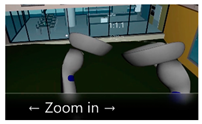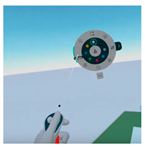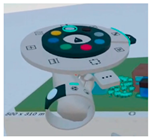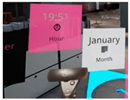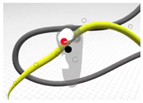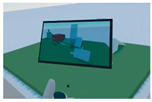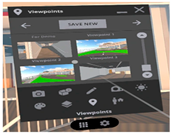Abstract
In this paper, we focus on interdisciplinary collaboration using intuitive virtual reality interfaces and building information models in the architecture, engineering, and construction industries. These systems have been a topic of research and development for the past ten years; however, there is still no widely open standard format, related software platform, or guidelines that are sufficiently mature; the complexity of such systems is very high. We review existing state-of-the-art interdisciplinary collaborative virtual reality systems, proposing solutions and standards. Thirteen state-of-the-art systems are reviewed and compared to illustrate emerging trends and insufficiencies. It is found that these systems differ significantly with respect to drawing capabilities, photorealism, construction simulation, and interdisciplinary communication. We discover trends in user interfaces that could be evolved to better standards, and provide future guidelines to developers. Combining the best aspects of existing systems, we provide a blueprint for an ideal system that combines the most advanced features for collaborative design.
1. Introduction
Advances in information and communication technology affect many aspects of the architecture, engineering, and construction industry (AEC). New tools and infrastructures improve practices and achieve better results. For example, building information modeling, often known as BIM, introduced by Van Nederveen and Tolman in 1992, drastically transformed the industry [1]. Recent innovations in virtual reality technology (VR) are paving the way for new “virtual” working environments and changing the way engineers work. For example, high-resolution headsets achieve photorealistic experiences [2], and advanced graphics engines and graphics cards offer optimized performance without sacrificing detail. However, VR has been slow to penetrate the AEC industry, as noted by [3]. Our goal is to collect scattered efforts, compare the features of each approach, and track barriers, so as to provide instructions for improving collaborative systems.
In Section 1 of this paper, we present the background processes currently followed in the AEC industry, as well as advantages and disadvantages regarding VR use as noted in the literature. In Section 2, we present existing VR solutions and perform a comparison. In Section 3, we describe the ideal VR system. Finally, in Section 4, conclusions are derived and the future of VR is discussed. In the end, we provide a table explaining acronyms for the reader’s convenience.
1.1. Background
To enhance collaboration among different disciplines and expedite information exchange and outsourcing procedures, the industry takes advantage of several technological advancements. Computer-aided design (CAD) constitutes an indicative example of such an advancement that is widely employed. CAD is a form of computer-assisted building modulation that architects, engineers, and contractors use to design and depict two- and three-dimensional models. A similar technology recently introduced in the AEC sector, revolutionizing the industry, is computer-aided engineering (CAE). This term encompasses finite element analysis (FEA), computational fluid dynamics (CFD), and multibody dynamics (MBD) for durability and optimization.
Although all aforementioned technological advancements played a critical role in the development of the industry, the need for further interdisciplinary collaboration led to the development of more efficient and sophisticated standards that oversee the process of creating and managing a digital model of a building. Therefore, BIM was created. BIM is an intelligent, model-based process that connects AEC professionals, allowing them to design, build, and operate buildings and infrastructure more efficiently [4]. Using BIM, designers enhance digital 3D models that include data associated with physical and functional characteristics. The data in a model define design elements and establish behaviors and relationships between model components.
There are a number of BIM “levels of maturity”, as shown in Figure 1. Level 0 describes unmanaged CAD, Level 1 describes managed CAD in 2D or 3D, and Level 2 involves developing building information in a collaborative 3D environment with data attached, but created in separate discipline models (often called closed BIM). Level 3 BIM, also known as iBIM or OpenBIM, refers to collaborative construction sequencing and cost and life-cycle management information [5]. OpenBIM extends the benefits of closed BIM by improving the accessibility, usability, management, and sustainability of digital data. At its core, OpenBIM is a collaborative process that is vendor-neutral. OpenBIM processes can be defined as sharable project information that supports seamless collaboration for all project participants. However, OpenBIM has several unresolved issues such as model ownership, design responsibility, lack of standardization, and liability in interoperation among partners [6]. The Industry Foundation Classes format (IFC) is a first step towards standardization; however, it does not encompass the entire collaboration process, as it is a standard for the final submission of a project which is not reversible and functional for each collaborator [4]. There is a need for more advanced formats and software platforms that allow seamless collaboration.
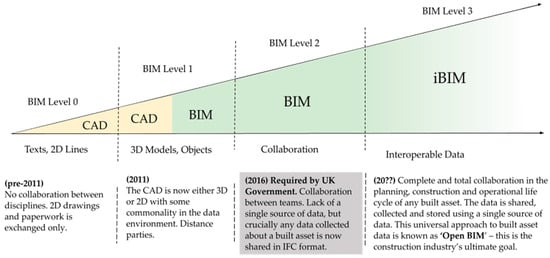
Figure 1.
BIM Collaboration Levels Maturity.
1.2. Advantages and Disadvantages of VR
VR has several advantages, but it also has many disadvantages, as noted in [3,7].
1.2.1. Advantages
Visualization and Drawing: The most prominent characteristics of VR in this category are:
- (a)
- Interactivity: users can interact with models;
- (b)
- Spatiality: models are represented in three spatial dimensions;
- (c)
- Immediacy: real-time feedback from actions is given without noticeable pause;
Telepresence: the virtual presence of collaborators in a VR environment eliminates the need for their physical presence. A system that relies on VR technology can enhance training speed and quality, be pandemic immune, and reduce travel costs for meetings;
Simulation: on-site task simulation can address a number of issues during construction, such as the feasibility of operations.
1.2.2. Disadvantages
BIM model preparation: It takes extra work and time to visualize a BIM model in VR; incompatibilities such as the lack of common 3D data structures and material systems across existing software are the main cause.
Adaptation to VR interfaces: VR controllers and hand gestures provide new interfaces that are often different across VR vendors and cause cognitive stress.
2. Existing VR Solutions for the AEC Industry
We reviewed mature commercial VR solutions in order to derive useful conclusions. The development of VR systems shifted to certain companies as it is not easy for academia to engage in such a demanding task; therefore, no open-source solution exists yet as a baseline. In Section 2.1, we present existing VR solutions, in Section 2.2 we outline interconnection solutions for VR with existing CAD/CAE/BIM systems, and in Section 2.3 we provide an analysis of the features of each VR and interconnection solution.
2.1. Existing VR Solutions
In Table 1, we present several VR solutions. They are explained in great detail in the following paragraphs.

Table 1.
Existing software solutions in the AEC industry.
Arkio is a drawing VR software [8]. It covers a wide variety of drawing actions through its radial menu which is located on the left wrist (Figure 2a), but it can be anchored wherever in space (Figure 2b). A band on the wrist indicates the current selected drawing action. The radial tool allows object drawing (Figure 2c) as well as object coloring (Figure 2d), but it does not go further into highly realistic material properties and ray-tracing. Another innovative interface is the zooming, scaling, and rotating interface which is based on the distance of two hands, e.g., by holding the left and right grab buttons and lowering or increasing the distance, the zoom goes up or down (Figure 2e). A virtual camera can be used to take screenshots (Figure 2f) and a 3D slider can be used to change the time of day in order to see the shadows’ position (Figure 2g). It can import and export files for Rhino, Revit, Sketchup, and BIM360, but it is not live interconnected.
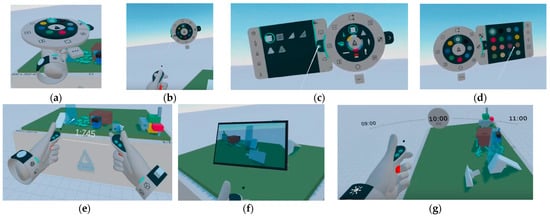
Figure 2.
Arkio VR interfaces: (a) toolbox at left hand; (b) pin toolbox; (c) select mesh functionality; (d) select color functionality; (e) scale avatar with both triggers on hold; (f) capture screenshot; and (g) change time of day.
Enscape targets real-time realistic rendering. It also provides plugins for Revit, SketchUp, Rhino, Archicad, and Vectorworks for “Live Updates”. It aims to improve workflow among architects and clients by presenting photorealistic renderings of the design. One of its major disadvantages is that it does not support multi-user capability in real-time. It is based on an in-house graphics engine. Its advantages are that it can extend the materials library of Revit and also simulate daylight at any time point. The right controller can be used for teleporting, i.e., the instant change of view to a location without intermediate rendering of walking (Figure 3a). The left controller has an attached menu as shown in Figure 3b that can be used for various modes such as seated, room walking, walking, and flying. In Figure 3c, the presentation mode for teleporting to specific positions can be seen. In Figure 3d, a mini-map for teleporting is demonstrated. In Figure 3e, screenshot capturing and image presentation functionalities are shown. In Figure 3f, interconnectivity with Revit is demonstrated. Changing material into white clay, showing object outlines, and time-changing interfaces are demonstrated. The controllers can also be used for walking or flying in 3D, but this is not advised as it may cause VR sickness.
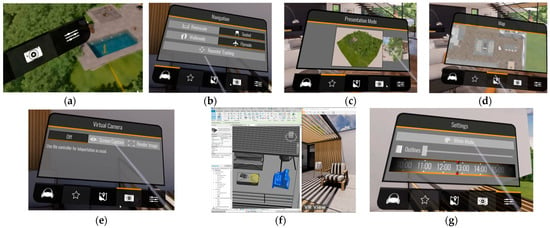
Figure 3.
Enscape VR interfaces: (a) teleport; (b) fly vs. walk; (c) teleport to certain spots; (d) map of scene; (e) screen capturing; (f) interconnection with Revit; and (g) change daytime.
Fuzor is a multiuser VR software focusing on construction simulation. It can represent the construction site in VR together with vehicles, e.g., it allows for positioning building machines such as trucks and cranes. It can be interconnected with Revit, ArchiCAD, Rhino, and Navisworks through Live Link, which does not require file synchronization. The synchronization is bidirectional, i.e., changes can pass from one software to the other. It has multi-user presence capability. Another capability is to represent 4D scenes, i.e., the construction process through time. Its interfaces are shown in Figure 4. The main menu allows one to select between walk and fly modes (Figure 4a). Navigation is based on teleporting with the right controller (Figure 4b). The “Render” mode allows changing the daytime (Figure 4c). The “Pipes” menu allows drawing pipes by first selecting their diameter and then dragging the left controller (Figure 4d,e). The render modes menu also allows placing pre-built 3D items in space, as shown in Figure 4f. Finally, the elements property menu allows one to see BIM information for an element, as demonstrated in Figure 4g.
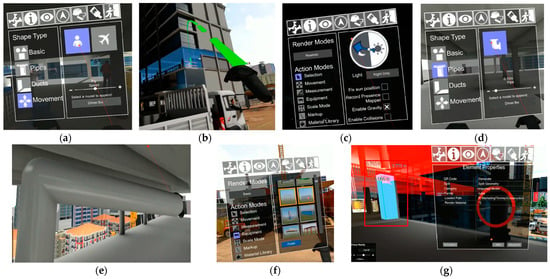
Figure 4.
Fuzor VR interfaces: (a) walk vs. fly mode; (b) teleporting; (c) render modes; (d) create pipes; (e) drawing pipes; (f) equip scene for simulation; and (g) query models.
Gravity Sketch is a drawing tool for designing complex curves. When a drawing tool is selected, the right controller becomes transparent so as not to hide the drawing, and the drawing obtains several holders with round marks for further editing (Figure 5a,b). The left controller activates the menu (Figure 5c) which has a horizontal bar with design tools. A vertical bar has auxiliary functions such as drawing in a mirrored fashion (Figure 5d). The purple button on the left controller is a shortcut for drawing tools (Figure 5e). The gear icon on the menu can bring up files from the file system as a reference point (Figure 5f). Additional features supported include multiplayer capability, various devices (tablet, desktop) support, import and export models in various formats, and live interconnection with Rhino.
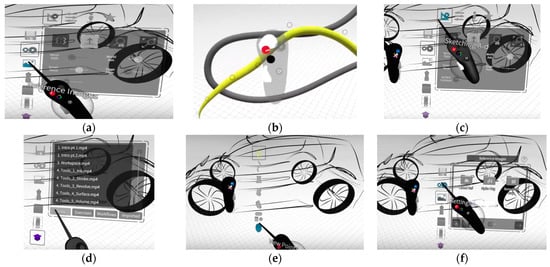
Figure 5.
Gravity Sketch interface: (a) draw mode selection menu; (b) draw curved meshes; (c) sketching aids, measurement; (d) see videos; (e) tool selection; and (f) folder selection for reference images.
Holodeck allows architects to annotate and reposition objects collaboratively. Its user interface consists of a table, named “HoloTable”, and many hand attached widgets. HoloTable’s main menu contains the tabs “Table, View, Sun Position, and Clip”, as shown in Figure 6a. Various widgets on the left side of the menu allow the scaling of the model, and the positioning of the player inside the model. The “Table” tab contains widgets for changing the properties of the Holotable; namely, its translation, rotation, and vertical displacement. The “View” tab filters parts of the building with switches as shown in Figure 6b. The “Clip” tab contains sliders for the vertical and horizontal cross-sectioning of the 3D model. The hand menu contains widgets, as shown in Figure 6c,d, which contain multiplayer options, measurement tools, viewing angle change options, a materials library, and a screenshot-taking tool. An embodied web browser allows live interconnections with Google Hangouts (Figure 6e). The design tools allow for 2D and 3D sketching as shown in Figure 6f,g, respectively. The materials library contains several options and a palette for choosing existing materials, as shown in Figure 6h,i. Its plugins for 3DS Max and Maya can be used to import models inside VR.
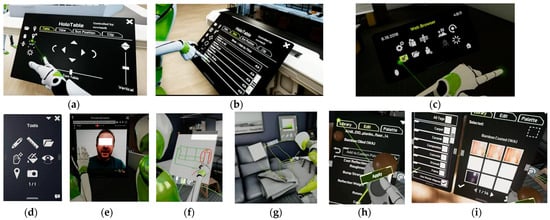
Figure 6.
The UI of Holodeck: (a) turn the table; (b) select layers to hide; (c) open a web browser; (d) palette; (e) conferencing; (f) 2D Sketching; (g) 3D Sketching; (h) apply material; and (i) materials library.
“IrisVR” merged with “The Wild” in February 2021. IrisVR—The Wild is a VR software mainly targeting multi-discipline review and collaboration within VR. Its UI has several tools such as (a) the “Inspection” tool (Figure 7a), with the capability to view information fetched from Revit; (b) the “Viewpoints” tool (Figure 7b) which allows teleporting to certain points in space; (c) the “Layers” tool, which allows changing the visibility of Rhino layers (Figure 7c); (d) the “Markup” tool that allows annotating the model with 3D brushes (Figure 7d); (e) the “Screenshots” tool to take screenshots with a camera preview board (Figure 7e); and (f) the “Sun Settings” tab for changing the time of day and date to observe the lighting effect on the 3D model and the position of its shadow (Figure 7f). Iris VR has an in-house developed plugin named Prospect that can import models directly from Rhino, Revit, NavisWork, BIM360, and Sketchup.
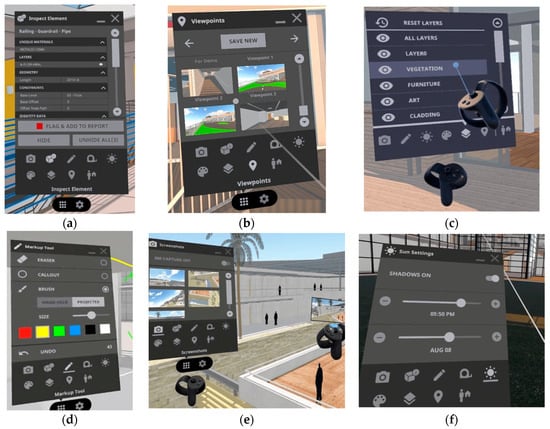
Figure 7.
The UI of Wild-Iris VR: (a) inspect 3D models; (b) change viewpoint; (c) switch on/off layers; (d) markup tool; (e) save screenshot images; and (f) time of day change.
The logic behind Mindesk is inversely set, as opposed to other VR solutions. Instead of having one standalone software interconnected with Rhino, Revit, and Unreal Engine, we have in this case three VR plugins, one for each platform, which can communicate with each other. The main plugin is the Rhino plugin which contains an extensive set of tools such as Grasshopper tools (Figure 8a) and several polysurfaces and NURBS tools (Figure 8b) able to exploit Rhino capabilities in advanced curves design. The Revit plugin has a basic interface where (as with much any other software) zooming is controlled by holding the grab buttons and approximating the controllers (Figure 8c). The main menu consists of five tools: “Selection”, “Screenshot”, “Inquire”, “Ruler”, and “Pen”. The “Inquire” button fetches BIM information from Revit as shown in Figure 8d, whereas “Pen” allows sketching in 3D as shown in Figure 8e. Multi-user capabilities are offered for users on the same local network (LAN). The Mindesk Unreal VR plugin offers affine transformations using live link interconnection to Rhino software. Grasshopper geometries can also be transferred to Unreal. The main advantage of Mindesk is its live interconnection feature, which reflects any change made in one plugin to all the others in real-time without the need of pressing sync buttons or exchanging files.
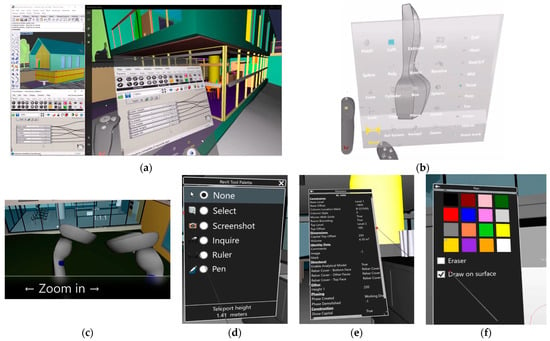
Figure 8.
Mindesk plugins for Rhino in (a,b) and plugins for Revit (c–f): (a) use grasshopper inside VR; (b) select drawing tools from Revit; (c) zooming with both hands; (d) tool selection; (e) inspect model; and (f) annotate on model.
Twinmotion is a visualization software that allows architects and clients to construct photorealistic representations of buildings, virtual inhabitants, and the surrounding scenery [9]. Its menu is attached to the left controller; the right controller is used for clicking on items or teleporting (Figure 9a). The menu has five options, named “Settings”, “Floor level calibration”, “Weather condition change”, “Presenter”, and “Materials”. The settings option (Figure 9b) allows one to change graphics settings among four presets (Low, Medium, High, and Ultra) depending on the hardware available (Figure 9c). The “Weather” button allows one to change conditions such as hour, month, weather, and season (Figure 9d). The buttons slide up and down to regulate the selected value. The “Materials” button leads to five categories of materials, including glass, metal, concrete, wood, and stone (Figure 9e). When the in-scene model to be edited is clicked, a choice can be made from the available sub-materials, as shown in Figure 9f. The “Presenter” button leads to choices for teleporting (Figure 9g) that were predefined in the 2D interface. Twinmotion has export and import options for Unreal, Revit, Rhino, and other tools, but does not support live changes in real-time or multi-user functionalities.
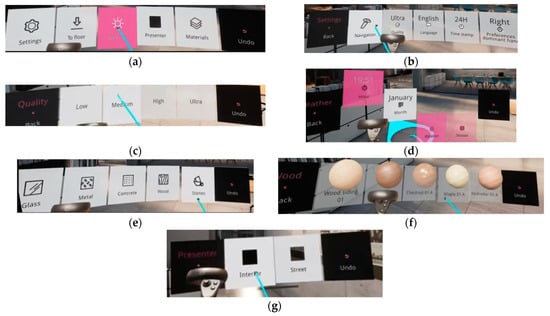
Figure 9.
Twinmotion VR UI: (a) main toolbar; (b) settings menu; (c) quality change menu; (d) light conditions change menu; (e) materials library menu; (f) materials selection; and (g) viewpoint selection.
2.2. Comparison
In this section, we compare VR solutions regarding their main characteristics, namely:
- (1)
- Scope: which phase of the project they target, and which discipline(s);
- (2)
- Broadness: how many disciplines they can target;
- (3)
- Features: the most important features available;
- (4)
- Multi-user capability: for real-time collaboration;
- (5)
- Design capability: to design at vertice level (not just simple affine transformations);
- (6)
- Texture support: support textures rather than only simple colors;
- (7)
- Interconnectivity: how they are interconnected to other software.
The results can be seen collectively in Table 2, and are described in detail in the following paragraphs.

Table 2.
Capabilities of existing VR software in the AEC industry.
Arkio, Gravity Sketch, and Mindesk have advanced design features at the vertices level. Mindesk supports the full drawing capabilities of Rhino, such as polysurfaces and NURBS. Gravity sketch supports natively drawing with mirroring, NURBS, and splines. Arkio put effort into the radial menu, which very intuitively presents the tools selection options. Comparing these three, Arkio has the best UI experience; however, it lacks NURBS drawing. Mindesk has the most drawing features; however, it requires Rhino to achieve them. Gravity sketch has a quite good range of drawing capabilities and can be used as standalone software.
Fuzor, IrisVR, and Mindesk are collaboration and BIM information tools in VR. Their role is to allow the inspection of BIM information for problem-solving. The advantages of Fuzor are that it is highly realistic, provides a 4D simulation of the construction, and also allows pipe editing. IrisVR provides fewer features, but has a very intuitive user interface. Mindesk plugin for Revit is a rather new plugin with few features. Fuzor and Mindesk are live interconnected with Revit, whereas IrisVR should be synced with file exchange.
Twinmotion, Enscape, and Holodeck offer advanced visualizations that can be used for project presentations. They all support real-time ray tracing (RTX), textures, and daylight-changing interfaces. In particular, Twinmotion allows for AI avatars, vegetation growing, materials changing, and weather changing. A disadvantage is that Twinmotion’s VR interfaces are a subset of the desktop interfaces for avatars and vegetation configuration. Enscape offers basic features for rendering. Holodeck also provides multiuser support and 3D markup drawing. They all support affine transformations communication to Revit with file syncing.
2.3. Interconnection Solutions
In this section, we analyze state-of-the-art methodologies to transfer data from CAD/CAE/BIM software into VR and vice versa. Interconnection solutions can be divided into importing/exporting files, sending data to a central server, and using live link communication. Particularly interesting is central server communication, as data are permanently stored in a database where they can be retrieved, reviewed, and edited at any time. A common standard should be adopted to achieve interconnection. In Table 3, we summarized some open standards and software for that purpose. These are analyzed in the following paragraphs.

Table 3.
Existing solutions for software interconnection.
3DRepo is a full-fledged solution for remote collaboration based on web interfaces (Figure 10a). It supports interconnection through its plugins for Revit, Navisworks, Autodesk, Civil 3D, Autocad, Unity, and Unreal. It can be used for clash detection, issues tracking, diffing, safety issues detection, and permissions allocation (Figure 10b). It is based on MongoDB and RabbitMQ servers [10]. Although it is provided as open-source, the asset creation is based on the transformations of assets in a Unity format, which is closed source.

Figure 10.
3DRepo web user interface: (a) issues list with 3D markers and (b) permissions allocation.
The Buildings and Habitats object Model (BHoM) is a universal object definition framework implemented as a set of open-source reference plugins for many platforms. It defines a common interface for software to work in parallel. It targets AEC organizations that develop their own software so that the final result follows a standard and can potentially be interconnected. It lacks central database implementation but can be used as a baseline standard for making such a database. It supports major brands such as Revit, Rhino, SAP2000, Unreal, and Unity.
Omniverse offers asynchronous collaboration through a central database named Nucleus, as shown in Figure 11. It is based on Pixar’s USD format for assets and scenes transfer. Omniverse Nucleus works via TCP/HTTP in a publish/subscribe model, where multiple clients are connected to it in such a manner that when one client submits a change (publishes it), every other client (subscriber) will immediately receive that change. One constellation of collaborators can have multiple Nucleus databases that can be synced (e.g., A and B, where A is used for architecture and B is used for mechanical, electrical, and public health (MEP) engineering). Several connectors (plugins) connect Rhino, Revit, Maya, Blender, Unreal and other software with Nucleus, as shown in Figure 11. NVidia provides a toolkit allowing one to develop their own plugin, as well as a physics simulation engine and an RTX toolkit for realistic representations.
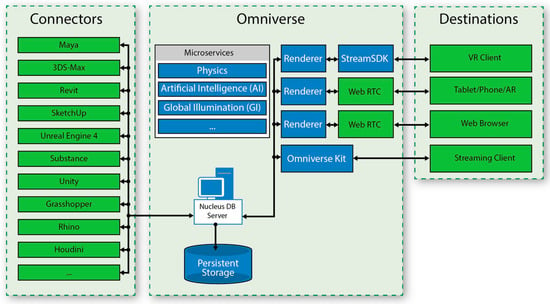
Figure 11.
Omniverse architecture.
Re.AKT software was developed in-house at AKTII over the past 10 years. Re.AKT interfaces directly with a range of industry-leading modeling, BIM, structural analysis, and drawing production software packages to form an interlinked and holistic design environment. This toolkit enables design teams to rapidly collaborate and refine their work, ensuring that all aspects of a project can be coordinated through a single ‘master model’. Re.AKT currently provides a complete connection between the following software and schemas: SAP2000 (v19, v20, and v22), Sofistik, ETABS, Karamba, Rhino, Grasshopper, the IFC format (therefore, Revit, Microstation, ArchiCAD, etc.), and many of AKT’s in-house developed tools (such as AKT Carbon and AKT Unity). Partial connectors also exist for Robot, Karamba, OpenSEES, Speckle, and native Revit elements. When software packages connect to Re.AKT, their data classes and elements are exported and converted into AKT’s underlying data classes: AKT.Core. Converting all elements to AKT.Core ensures that the same robust and low-level data formatting and compression processes can be applied to all data, irrespective of where they came from.
Speckle is the Git of 3D design for the AEC industry. It provides the infrastructure for pushing and pulling data to a joint repository in commits and branches, as shown in Figure 12. Speckle provides a common specification for data to be processed by popular AEC software and in parallel provides an open-source software used for synchronizing. Its API is based on GraphQL REST API and its database is based on PostgreSQL, which has the potential to be extended on a large scale. An instance of the server is also offered for free as a service (https://speckle.xyz (accessed on 7 June 2022)). An organization can also install the server technology on its own premises. It has a web back-end named “Dashboard” that can be used to inspect data in the cloud. Its current version supports Blender, Revit, Rhino, Grasshopper, Autocad, Excel, Dynamo, Tekla, Microstation, Unity, and Unreal. Its advantages include its openness, low cost, portability, and wide range of connectors. Its disadvantages are a poor permissions management system, as it has only three roles for an entire project (owner, contributor, reviewer), and the lack of a branch merging mechanism, as merging should be performed using Grasshopper software.
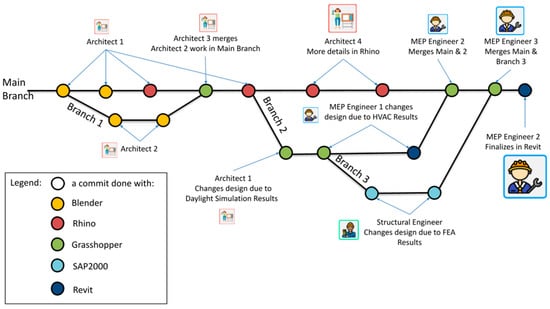
Figure 12.
Speckle concept in a graphic representation.
Overall, the aforementioned interconnection solutions rely on their own format, so they are not compatible with each other. Apart from BHoM, which is only a schema, all the other solutions offer software such as plugins and databases. Among them, only Speckle is completely open-source and free to use. Omniverse is a solution with a wide range of features, e.g., it supports digital twins and MEP-related applications.
3. Proposing a System for Multi-Disciplinary Collaboration in VR
In this section, we propose how the ideal VR system for cross-discipline collaboration could function from a technical perspective, namely by merging various technologies mentioned in Section 2. A VR collaborative system for AEC should ideally cover all different phases of AEC projects with proper functionalities and user interfaces. The VR system should communicate with existing software tools used in the AEC industry so that designs can be reciprocal in the traditional working chain and comply with standards (such as the IFC standard) as exported from Revit or Rhino software. In Section 3.1 we collected certain VR interfaces across solutions that were found useful and can serve as development guidelines for the ideal system. Next, in Section 3.2, we present an interconnection pipeline for synchronous and asynchronous collaboration which can be part of the ideal system.
3.1. UIs Guidelines
In Table 4, we summarize in the first column the most important features found in the review of the solutions in Section 2.1. How this feature was implemented by the majority of vendors is outlined in the second column. In the third column, we propose a directive that can be extracted from the findings described in column 2.

Table 4.
Guidelines for VR interfaces.
3.2. Optimum Interconnection and Collaboration Schema
The general scope is to enhance collaboration in immersive spaces by providing tools that enable a smooth workflow before, during, and after the construction of a building. The fragmented nature of the architecture, engineering, and construction industry is well recognized, and has led to several documented problems ostensibly relating to failures in communication and information processing [12]. In the Draft Safety Bill [13] currently under review, UK legislation is introducing the golden thread principle, requiring a detailed and traceable safety record of all the decisions made throughout the lifetime of the project, from early decisions during design through to legacy handovers as well as maintenance and repairs of the completed building. This highlights the need for a unified review and record-keeping platform that can be used to consolidate and keep track of the review and decision-making process during the entire lifecycle of a project. This can be achieved in an optimal way in VR; bringing the embodied experiential aspect to the simulated project facilitates the most informed and realistic encounter with the developing design. We envision VR as a review space; i.e., a communication, visualization, and project management tool that handles high-resolution immersive space as well as documentation and recordkeeping, allowing all parties involved in the creation and maintenance of a building to converge in a single experiential space.
There are several challenges that should be met in order for a single VR environment to cover the collaboration needs in the industry. A major challenge is supporting two types of collaboration: synchronous and asynchronous collaboration modes. In the synchronous mode, collaboration takes place in real-time; therefore, it can be used for discussing/examining issues and negotiating/resolving conflicts before solidifying them into released versions. At the implementation level, data are transferred with shared memory access for software programs that are connected through fast network topology, e.g., with the Live link technology of Unreal. VR tools that implement this type of interconnection are Fuzor and Mindesk. In the asynchronous mode, individual contributions have to be merged and saved in the master project by one person. It can be considered as the pull-merge-commit-push mechanism of the Git code versioning system. This is important due to the fact that AEC partners may reside in places that have completely different time zones, and need a way to update the design using a differential methodology, i.e., without storing a replica of the entire design just for a small change. Omniverse and Speckle are representative examples that offer software for a central database, REST TCP APIs, and connectors for many design software.
Another important challenge is the communication of the VR environment with existing tools such as Revit, Rhino-Grasshopper-Ladybug, SAP2000, Autocad, and Navisworks (to name just a few) which offer extra functionalities and provide the final release format. For example, Revit has a large database of building information modeling (BIM) objects [14], Rhino can design complicated 3D models based on mathematical functions [15], Grasshopper-Ladybug can perform annual daylight or thermal simulations [16], and SAP2000 can provide structural simulation 3D models [17]. There is no format that is acceptable by all vendors that can serve all the phases of a project from concept drafting and designing to integrating engineering solutions, to formulating construction details, and providing a maintenance plan. There have been some steps toward a joint format (e.g., using the IFC format) [18], but so far IFC is a lossy format across software vendors, and therefore used only for final project submission towards legal approval, usually via Revit.
3.3. Establishing a Theoretical Framework for Collaborative Design
We envision authoring an architectural project as an iterative process where the designers alternate between decision making (e.g., selecting/placing different materials and components) and previewing the result of their previous decisions so as to make new ones. Insufficient perception of the impact of their design choices may lead to badly-informed decisions and, in turn, to suboptimal design choices [19]. In addition, the design process of architectural projects is characterized by high complexity which stems from the problem of “parallel worlds”, a term used to describe the fact that several disciplines (architects and a variety of engineers) coexist in an architectural project, each with distinct requirements and roles. However, only “intersection”, by means of the close collaboration of these “parallel worlds”, can bring an architectural project to fruition. This “parallel world” aspect creates the necessity for an interdisciplinary tool capable of addressing the unique requirements of each discipline both individually and simultaneously, where all authors are able to work on the same architectural project and perceive it in their own, different way, as best suits their needs. This fact dictates the necessity for a “decomposition” of the architectural project into components that meet the needs of individual disciplines. Similarly, there is also a need for a “composition”, where individual designs, created separately, can be merged to form a unified architectural project.
Given the aforementioned needs, the ideal system for multi-discipline collaboration should implement the asynchronous collaboration mode, as mentioned in Section 3.2, which will be the backbone of the system. It should provide: (a) a central database that will always contain the latest version of the design for any discipline; (b) the presentation of the partial designs united in one common format; and (c) translation of this format back to the discipline dedicated format for on-screen editing. Next, the system should implement the synchronous collaboration mode which allows designers to co-exist in the same space and time, so as to solve design issues.
In Figure 13, we depict the concept of the proposed system in a diagram that merges these two collaboration modalities. The horizontal dimension represents asynchronous modality, allowing any changes on the AEC project to be stored persistently in a database; the vertical dimension represents synchronous modality, allowing real-time collaborative design. The scenario is as follows. On Date 1, an architect formulates the concept of the project in drafting software, such as Blender 3D or Maya, and pushes this design to the database using asynchronous mode. On Date 2, multiple architects pull the initial draft from the database using asynchronous mode connectors to Blender, Rhino, and VR, the latter made with Unreal or Unity Graphic Engines. They contribute to the initial draft design in real-time using synchronous mode connectors that allow for collaborative design. Then, the principal designer pushes the design back to the database using an asynchronous mode connector.
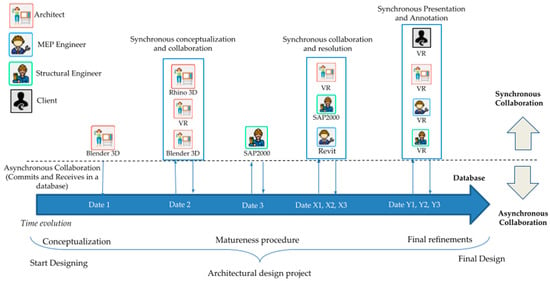
Figure 13.
The ideal VR system for collaborative design in AEC.
On Dates X1, X2, and X3, other disciplines can be involved. A MEP engineer can commit changes into the database from Revit by working synchronously with structural engineers in SAP2000 and an architect in VR. Additionally, in other cases all disciplines can work collaboratively inside VR to resolve conflicts, and one of them can push the final design into the database (e.g., on Dates Y1, Y2, and Y3,). It is possible to commit changes into the database from any type of software for each stage of the project, i.e., Blender 3D for drafting, Rhino 3D for architectural design, SAP2000 for structural simulations executions and proposing changes, Revit for committing engineering plans, and VR for collaborative design and conflict resolution.
3.4. Implementation Pathway
In the following, we propose an implementation blueprint for the theoretic system proposed in Section 3.3. It is represented by the diagram shown in Figure 14. On the left-hand side is onscreen software such as Rhino, Revit, SAP2000, and Blender, which represent what already exists in the industry. It is often called the AS-IS scenario by the IEEE830 requirements analysis standard [20]. These software were selected indicatively; however, other software can also be interconnected, as the system is modular. On the right-hand-side is the proposed VR software, which represents the TO-BE scenario [21]. In the center of the system we placed a Speckle system database, as it provides the benefits of a system that is open source and focused only on the AEC industry. It relies on Speckle connectors and Speckle object notation used to translate Revit, Rhino, and SAP2000 into a JSON text schema and save them within a PostgreSQL database through a commit mechanism. Communication with the Speckle database is achieved with REST HTTP GraphQL API (black lines). Alternatively, other closed source systems for interconnection can be used as described in Section 2.3.

Figure 14.
Explaining the collaboration among AEC disciplines using the proposed architecture.
The synchronous mode across VR and non-VR software is implemented with real-time data transfer achieved using Mindesk real-time transfer technologies such as memory access and Live-Link (blue lines). For example, the designs from Rhino can be transferred in real-time within VR; this is important, as Rhino has complex surface design tools that are difficult to implement in VR. Unreal Engine was selected as the overall graphics engine for VR as it offers photorealistic rendering of a higher quality level than other graphics engines.
The usage scenario is as follows. Architects 1 and 2 use Blender to draft the design concept collaboratively through the Speckle Blender connector (as shown on the left-hand mid-side of Figure 14). Next (left-hand side bottom), Architect 2, Architect 3, and other disciplines in Rhino can fetch the concept design, collaboratively make edits synchronously through the Mindesk connector, and commit the changes with the Speckle Rhino connector to the database. Structural engineers (upper left-hand side) can pull the design from the database and make simulations using either SAP2000 or Grasshopper-Karamba. Re.AKT connector can be used for communication between SAP2000 and the database. The Grasshopper Speckle connector can be used to push Grasshopper simulation geometries to the database. The Mindesk Grasshopper connector can be used for collaboration across Grasshopper users. MEP engineers (left-hand top side) can use Revit and Speckle connectors to fetch the design from the database, make MEP plans, work synchronously with other MEP engineers through the Mindesk connector, and submit changes to the Speckle Database through the Speckle connector.
VR technologies are found on the right-hand side. Architect 4 can be immersed in the VR environment and fetch the latest design through the Speckle Unreal connector. The Mindesk Unreal connector can be used to interconnect Unreal with Revit and Rhino. As the database contains a large amount of BIM information from Revit, VR design capabilities can be enhanced through a “semantic” module service. It can be offered using a knowledge base service used to interrogate the database for semantic information across commits (e.g., “fetch all users that modified this asset”). In addition, users can collaborate through Unreal Engine services such as Epic Online Services [20] for multiuser interaction and Vivox for audio communication [22].
4. Conclusions, Discussion, and Future Work
In our review, we discuss several issues regarding the collaboration of engineers within VR and between VR with on-screen software. Theoretically, VR collaboration systems are based on the concept of OpenBIM where information flows across disciplines. However, there are many technical issues to be solved before this happens in an efficient manner. We attempt to treat the technical side of the problem, and propose solutions that allow information to flow in a bidirectional manner from VR to on-screen software and vice versa. In our proposed ideal VR system, we attempt to treat collaboration with a centralized silo where all have access. Currently, much of the effort across VR vendors is consumed by maintaining the quality of the model when shifting to designing in VR and when transforming formats across graphic engines. This is due to the fact that each graphic engine vendor developed a closed source format, which can not be decrypted easily.
Apart from technical issues, a permissions and responsibilities system is missing from existing interconnection implementations. The current implementations stem from the field of software design for central databases (e.g., who has the authority to write, read or comment), which should be further researched and modified according to the needs of engineers. Such issues include model ownership, incorporation of BIM into the contractual relationship of the parties involved, design liability, reliance on data and the evolution and responsibility of the model, design responsibility, lack of standardization, litigation and protocol, working collaboratively, the role of the BIM coordinator, and sharing copyrighted data [6]. A theoretical approach to the treatment of legal issues can be found in the context of our project in [23]. However, it is beyond the scope of this study to extend the discussion in this direction. The permissions and responsibilities implementation methodology is a topic for future research and development.
As regards VR interfaces, there is a lack of standardization. For example, desktop 3D design software share the same interfaces for panning, scrolling, and zooming, or at least provide the option to change the interface to user preferences. This is not valid in VR software, as each vendor develops its own approach for each basic functionality. For example, it is not agreed if the user avatar should be scaled or the model should be scaled. When scaling down the avatar, the perception of space changes. In addition, the impression of other avatars at different scales causes disruption from tasks. All these issues, in conjunction with the derived guidelines in Section 3.1, are subjects for further investigation by informatics and psychology scientists. Usability studies should be performed using questionnaires and electronic methods (e.g., eye-tracking and analytics), to reduce the cognitive load in both perception and interaction.
In the future, VR collaboration systems could also exploit other technologies such as augmented reality, 5G networks, remote rendering, geospatial maps data, 3D scanning, mixed reality, and digital twins [24]. Today’s VR technologies are capable of intersecting the parallel worlds of the engineering disciplines in a common space that will promote designing and decision making that reshapes the collaboration process in architectural projects; however, great effort is required to increase usefulness and user friendliness so as to create an attractive and operational environment.
Author Contributions
Conceptualization and writing, D.V.; writing—review and editing, S.N.; supervision, I.K. All authors have read and agreed to the published version of the manuscript.
Funding
This project received funding from the European Union’s Horizon 2020 research and innovation programme under grant agreement No. 952002—“PrismArch: Virtual reality aided design blending cross-disciplinary aspects of architecture in a multi-simulation environment”.
Institutional Review Board Statement
Not applicable.
Informed Consent Statement
Not applicable.
Acknowledgments
We would like to thank Helmut Kinzler, Associate Director/Head of Virtual Reality, Zaha Hadid Architects; Edoardo Tibuzzi, Director of Computational Team, as well as Jeg Dudley, Computational Designer, both at AKTII; Arun Selvaraj, Senior Designer, SWECO; and Gabriele Sorrento, CEO, Mindesk; as well as their teams for their valuable advice.
Conflicts of Interest
The authors declare no conflict of interest.
Abbreviations
| AEC | Architecture, Engineering and Construction |
| API | Application Programming Interface |
| BHoM | Buildings and Habitats object Model |
| BIM | Building Information Modeling |
| CAD | Computer-Aided Design |
| CAE | Computer-Aided Engineering |
| FEM | Finite Element Modeling |
| GA | Grant Agreement |
| HTTP | Hypertext Transfer Protocol |
| IBC | International Building Code |
| IFC | Industry Foundation Classes |
| MEP | Mechanical, Electrical, and Plumbing |
| REST API | Representational State Transfer Application Programming Interface |
| TCP | Transmission Control Protocol |
| UI | User Interface |
| VR | Virtual Reality |
| XR | Extended Reality |
References
- Zaker, R.; Coloma, E. Virtual reality-integrated workflow in BIM-enabled projects collaboration and design review: A case study. Vis. Eng. 2018, 6, 4. [Google Scholar] [CrossRef] [Green Version]
- Varjo. Head Mounted Display for Virtual and Augmented Reality Training Applications. Available online: https://varjo.com/ (accessed on 15 December 2021).
- Noghabaei, M.; Heydarian, A.; Balali, V.; Han, K. Trend Analysis on Adoption of Virtual and Augmented Reality in the Architecture, Engineering, and Construction Industry. Data 2020, 5, 26. [Google Scholar] [CrossRef] [Green Version]
- Computer Integrated Construction Research Program. BIM Planning Guide for Facility Owners, 2nd ed.; The Pennsylvania State University: Pennsylvania, PA, USA, 2013. [Google Scholar]
- Kim, H.; Anderson, K.; Lee, S.; Hildreth, J. Generating construction schedules through automatic data extraction using open BIM (building information modeling) technology. Autom. Constr. 2013, 35, 285–295. [Google Scholar] [CrossRef]
- Robert, E.; Tim, M.; Adam, P. An investigation into the legal issues relating to building information modeling (BIM). In Proceedings of the RICS COBRA AUBEA 2015, Sydney, Australia, 8–10 July 2015. [Google Scholar]
- Badamasi, A.A.; Aryal, K.R.; Makarfi, U.U.; Dodo, M. Drivers and barriers of virtual reality adoption in UK AEC industry. Eng. Constr. Archit. Manag. 2021, 29, 1307–1318. [Google Scholar] [CrossRef]
- Arkio Collaborative Spacial Design: VR User Experience. Available online: https://www.youtube.com/watch?v=zc1UcBa-Q7o (accessed on 18 March 2022).
- Twinmotion, Virtual Reality for Architecture with Twinmotion—Webinar. Available online: https://www.youtube.com/watch?v=NvCjWUgqCXk, (accessed on 21 March 2022).
- 3DRepo, The Digital Twin Platform for BIM Data. Available online: https://github.com/3drepo/3drepo.io (accessed on 22 March 2022).
- Brösamle, M.; Mavros, P.; Hölscher, C. Report of Cognitive Issues in VR-Aided Design Environments and Usability Guidelines. PrismArch Project Technical Report D3.1. 2022. Available online: https://prismarch-h2020.eu/download/472 (accessed on 7 June 2022).
- Goulding, J.S.; Rahimian, F.P.; Wang, X. Virtual reality-based cloud BIM platform for integrated AEC projects. In ITcon Journal Information Technology in Construction, Special Issue BIM Cloud-Based Technology in the AEC Sector: Present Status and Future Trends; CASPA Publisher: Lismore, Australia, 2014; pp. 308–325. Available online: https://www.itcon.org/2014/18 (accessed on 7 June 2022).
- UK Ministry of Housing, Communities and Local Government. Draft Building Safety Bill: Forward Reforms to the Building and Fire Safety System; UK Ministry of Housing, Communities and Local Government: London, UK, 2020; ISBN 978-1-5286-2088-8. Available online: https://www.gov.uk/government/publications/draft-building-safety-bill (accessed on 7 June 2022).
- Jose, E.; Banawi, A.; Pena, E. Evaluating the benefits of introducing “BIM” based on Revit in construction courses, without changing the course schedule. Univers. Access Inf. Soc. 2018, 17, 491–501. [Google Scholar]
- Melendez, F. Drawing from the Model: Fundamentals of Digital Drawing, 3D Modeling, and Visual Programming in Architectural Design; John Wiley & Sons: Hoboken, NJ, USA, 2019. [Google Scholar]
- Mostapha Sadeghipour, R.; Pak, M.; Smith, A. Ladybug: A parametric environmental plugin for Grasshopper to help designers create an environmentally-conscious design. In Proceedings of the 13th International IBPSA Conference, Lyon, France, 26–28 August 2013. [Google Scholar]
- Scheller, J.; Constantinou, M.C. Response History Analysis of Structures with Seismic Isolation and Energy Dissipation Systems: Verification Examples for Program SAP2000; Technical Report MCEER-99-0002; Multidisciplinary Center for Earthquake Engineering Research, University at Buffalo: Buffalo, NY, USA, 1999. [Google Scholar]
- Ait-Lamallam, S.; Yaagoubi, R.; Sebari, I.; Doukari, O. Extending the IFC Standard to Enable Road Operation and Maintenance Management through OpenBIM. ISPRS Int. J. Geo-Inf. 2021, 10, 496. [Google Scholar] [CrossRef]
- Alizadehsalehi, S.; Hadavi, A.; Huang, J.C. From BIM to extended reality in AEC industry. Autom. Constr. 2020, 116, 103254. [Google Scholar] [CrossRef]
- Mouzakis, C.; Ververidis, D.; Girao, L.M.; Patz, N.; Nikolopoulos, S.; Kompatsiaris, I. Holistic Requirements Analysis for Specifying New Systems for 3D Media Production and Promotion. Sustainability 2021, 13, 8155. [Google Scholar] [CrossRef]
- Epic Online Services, EOS. Gaming Services for Multiplaying 3D Experiences. Available online: https://dev.epicgames.com/en-US/services-games (accessed on 15 December 2021).
- Vivox Audio Communication, a Service for Multiplaying 3D Experiences. Available online: https://unity.com/products/vivox (accessed on 15 December 2021).
- Kinzler, H.; Tadauchi, R.; Zolotareva, D.; Mnich-Spraiter, A. Sphereing: A Novel Framework for Real-Time Collaboration and Co-Presence in VR ZHVR White Paper; Zaha Hadid Virtual Reality Group: London, UK, 2021. [Google Scholar] [CrossRef]
- Rafsanjani, H.N.; Nabizadeh, A.H. Towards digital architecture, engineering, and construction (AEC) industry through virtual design and construction (VDC) and digital twin. In Energy and Built Environment; Elsevier: Amsterdam, The Netherlands, 2021. [Google Scholar] [CrossRef]
Publisher’s Note: MDPI stays neutral with regard to jurisdictional claims in published maps and institutional affiliations. |
© 2022 by the authors. Licensee MDPI, Basel, Switzerland. This article is an open access article distributed under the terms and conditions of the Creative Commons Attribution (CC BY) license (https://creativecommons.org/licenses/by/4.0/).
